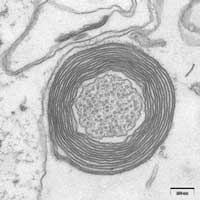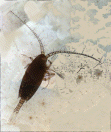 MYELIN EVOLUTION
MYELIN EVOLUTION

Updated 2015-07-26
Myelin is a multilayered membranous ensheathment of axons of the nervous system that greatly speeds conduction of nerve impulses. Its presence in nearly all vertebrate nervous systems reflects its multiple advantages. Best known and best characterized in vertebrates, where it is a key to subphylum success, it has arisen independently in at least three other (invertebrate) taxa: oligochaetes (earthworms), shrimp, and copepods (tiny planktonic crustaceans). The molecules, mechanisms and selective forces underlying this remarkable case of convergent evolution make a fascinating study. These pages attempt to outline what is known about myelin, its antecedents and its evolution and provide links to relevant sources and resources. [Please report factual erors, broken links, etc to Dan Hartline (danh at hawaii.edu)].
This information is presented in three, somewhat overlapping, categories:
- Background on myelin, what it is and how it function across all four taxa
- Evolution of rapid conduction. This is a step-back examining a variety of non-myelinated conduction systems (including plants) as comparative examples and precursors leading to myelination.
- Myelin phylogeny Background on the myelin of the different taxa in which it has evolved
- Researchers interested in the evolution of myelin [needs updating]
- 2007 NESCent meeting: "Myelin: a new model for evolutionary innovation" was held at Duke University September 16-19. The link is to pages with details on the program.
Links to related sites
 PBRC Home Page.
PBRC Home Page.
 Petra Lenz' Home Page
Petra Lenz' Home Page
 Dan Hartline's Home Page
Dan Hartline's Home Page
Acknowledgements & Disclaimers: In compliance with government regulation, be it known that
"This material is based upon work supported by the  National Science Foundation under Grants No. 9604505, 9906223, 0451376 and 0923692," and by NIH grant RR/AI-03061 to PBRC (Kenneth P. Mortimer, P.I.). Further, that "any opinions, findings, and conclusions or recommendations expressed in this material are those of the
author(s) and do not necessarily reflect the views of the National Science Foundation, the National Institutes of Health, or any other sponsoring organization."
National Science Foundation under Grants No. 9604505, 9906223, 0451376 and 0923692," and by NIH grant RR/AI-03061 to PBRC (Kenneth P. Mortimer, P.I.). Further, that "any opinions, findings, and conclusions or recommendations expressed in this material are those of the
author(s) and do not necessarily reflect the views of the National Science Foundation, the National Institutes of Health, or any other sponsoring organization."
 MYELIN EVOLUTION
MYELIN EVOLUTION

 MYELIN EVOLUTION
MYELIN EVOLUTION

 National Science Foundation under Grants No. 9604505, 9906223, 0451376 and 0923692," and by NIH grant RR/AI-03061 to PBRC (Kenneth P. Mortimer, P.I.). Further, that "any opinions, findings, and conclusions or recommendations expressed in this material are those of the
author(s) and do not necessarily reflect the views of the National Science Foundation, the National Institutes of Health, or any other sponsoring organization."
National Science Foundation under Grants No. 9604505, 9906223, 0451376 and 0923692," and by NIH grant RR/AI-03061 to PBRC (Kenneth P. Mortimer, P.I.). Further, that "any opinions, findings, and conclusions or recommendations expressed in this material are those of the
author(s) and do not necessarily reflect the views of the National Science Foundation, the National Institutes of Health, or any other sponsoring organization."